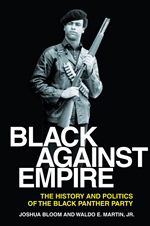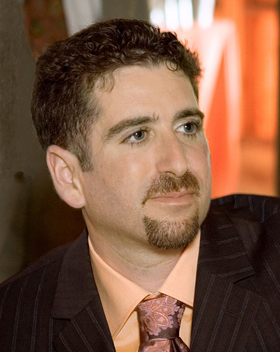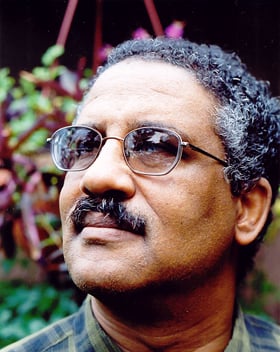Black Against Empire: The History and Politics of the Black Panther Party
Joshua Bloom and Waldo E. Martin Jr. on the rise of the Black Panther Party, revolution, and the glory of guns
Three young black men are cruising in a ’54 Chevy, armed with a shotgun, a handgun, and a rifle. It’s dark, and they’re following a police car on patrol in north Oakland. In the confrontation that follows, the young men hold firm, refusing to put down their weapons, and they attract a small crowd of bystanders. As historians Joshua Bloom and Waldo E. Martin document in their new book, Black Against Empire, Huey P. Newton and Bobby Seal, the quick-witted leaders of the Black Panther Party were on their way to building a revolutionary movement that has yet to be replicated in the United States.
The Black Panthers crafted their unique identity by advocating a form of “self-defense” that entailed militant defiance of police authority and brutality. Rejecting the U.S. government as a colonial force, the party united many Americans who felt oppressed, and became an icon of the global fight against American imperialism. I asked Bloom and Martin six questions about Black Against Empire, the rise of the Black Panthers, and the future of revolution:
1. What drew thousands of new recruits to the Black Panther Party’s message of violent revolution in an era otherwise marked by the peaceful protests of the civil-rights movement?
The peaceful protests of the civil-rights movement proved powerless to address urban poverty and ghettoization. Large numbers of blacks had migrated to the cities of the North and the West for wartime jobs. White and industrial flight left concentrated urban black poverty, and municipalities responded with brutal containment policing. Urban police and fire departments remained almost exclusively white. Blacks were shut out from political machines, underrepresented electorally, denied access to elite white colleges and universities, and mired in poverty. In the mid-1960s, inspired by the civil-rights victories over legal segregation, young black people in Oakland, Los Angeles, Chicago, New York, and cities throughout the country took up the cry for “Black Power!” They sought new ways of organizing to achieve economic and political power.
In the late 1960s, the Black Panther Party emerged as the exemplar. The Black Panthers weren’t alone in theorizing that the black community was a “colony in the mother country” and calling for self-determination as part of a global struggle against imperialism. What distinguished them was their advocacy of armed self-defense against the police. They recognized that young urban blacks were ready to stand up to police, as evidenced by Watts and the spread of urban black rebellion, and sought to organize armed resistance into a political force. Initially, the Black Panthers used the law to challenge police brutality while bearing loaded weapons. Soon, hundreds of black people were rallying armed in legal protests against police brutality. The State of California responded by changing the law to restrict the right to bear arms. But the party adapted. Attracted to both armed self-defense and such community programs as Free Breakfast for Children, young black people from across the country contacted the Black Panthers asking to open chapters. During the party’s peak, from 1968 to 1970, thousands of young blacks in close to seventy cities dedicated their lives to the party and to revolution, often at great personal risk.
2. In an iconic photo that was displayed in most Black Panther Party offices, Huey P. Newton is depicted with an ironclad grip on a rifle – an image that recalled for me Charlton Heston’s famous proclamation, delivered with a replica rifle held over his head, “From my cold, dead hands!” What do you see as the difference between the Black Panthers’ perspective on gun rights and that of the modern-day National Rifle Association?
The Black Panther Party took very seriously the foundational American idea that democracy requires the capacity to depose despotic government. The party frequently cited the Second Amendment, and prominently quoted the Declaration of Independence along these lines. Bearing arms was seen as a means to challenge police brutality and transform oppressive social conditions. Ironically, when the Black Panther Party figured out how to use gun laws to build political power, two Republicans, California governor Ronald Reagan and state assemblyman Donald Mulford, moved to restrict the right to bear arms. During that period, the NRA also endorsed gun control. Conversely, the current NRA proposal to militarize school campuses demonstrates little regard for the social conditions that generate violence and seems like a recipe to get a lot of children killed, especially black children in those districts with already-high levels of gun violence.
3. Fred Hampton, deputy chairman of the Illinois chapter of the Black Panther Party, was infamously shot point-blank in the head while he was sleeping, in what turned out to be a police- and FBI-directed assassination. How did government policies like defamation, espionage, and the embedding of provocateurs affect the party’s momentum?
Direct repression of the party actually fueled its growth from 1968 to 1970. The more the state raided Panther offices and jailed Panther leaders on flimsy charges, the more allies flocked to the party’s defense. Moderate black political organizations like the Urban League and the NAACP did not support the Black Panthers’ politics, but neither did they want to see young black activists assassinated by the state. Lots of non-black allies also felt threatened by state repression of the party, including many registered Democrats who voted against the Vietnam War and draft in 1968, only to have the national Democratic Party leadership push through a pro-war candidate and platform. Political, legal, financial, and organizational support from these allies bolstered the Black Panthers’ efforts, leading more and more young blacks to join up.
The government recognized this, and increasingly emphasized vilification over direct repression in its expanding campaign to destroy the party, relying heavily on agents provocateurs. Provocateurs on the government payroll advocated actions intended to scare away supporters, such as torturing suspected informants, killing rival activists, or bombing public buildings. Ultimately, however, the state succeeded in quelling social unrest through a series of concessions. As municipalities hired many more black police officers and firefighters, black electoral representation and black access to elite white colleges and universities grew, and the state rolled back the war and the draft, it became much more difficult for the Black Panthers to maintain support. In this context, state repression of the party became increasingly effective.
4. The Black Panther Party had a clearly defined leader, a minister of information, a minister of education, and a chief of staff. How did the party’s hierarchical structure affect its dynamics and its ultimate impact?
The organizational structure of the Black Panther Party was at once hierarchical and decentralized. In practice, most of the local chapters around the country organized themselves, and were not very accountable to the national organization. This structure was key to the party’s political ascent. The hierarchy provided the necessary discipline to advance a relatively singular political message, but decentralization insulated the national organization. Most armed Panther confrontations with police developed spontaneously – usually in defensive situations – with little direct involvement or responsibility from the top.
The national organization shepherded the party’s image, championed its legal defense, and coordinated allied support. But as state concessions made it more difficult for the party to maintain allied support, it increasingly sought to discipline local chapters, eventually calling on everyone to lay down arms. Local activists often chafed at such assertions of control, and these tensions eventually led to the party’s fragmentation and unraveling.
5. You meticulously researched the political history of the Black Panther Party. If history is indeed written by victors, how did you sort out truth from lies and legend? Do you see this book as an attempt to address, or even rectify, public perception of the party?
In part fostered by the state’s endeavors to vilify the Black Panther Party, distortions abounded. Initially, we intended to get to the truth through interviews, and we interviewed a lot of people, including many of the living former leaders of the Party. These discussions were invaluable for giving us a feel for life inside the Party and for checking our understandings. But it soon became clear, after forty years of unraveling and infighting and subsequent politics, how contradictory the accounts were: our informants disagreed not only in their explanations, but in the basic facts they recalled. To sort out the truth, we relied almost entirely on documentary evidence and interviews conducted immediately after the events described. Fortunately, there were mountains of evidence available – between documents created by the party, the government, allies, the alternative and mainstream press, and two new archives we developed, including a complete collection of the party’s newspaper and 30,000 hours of audio – the real challenge was to make sense of the evidence. We worked tremendously hard at this and would like to think that the twelve years we spent working on the book brought the story together. But our effort was really just the culmination of work done in the past several decades by hundreds of people, both former activists and a new generation of scholars.
Much like the party in its heyday, the history of the Black Panther Party has proven irrepressible. Dozens of memoirs, published and unpublished, and more than ninety doctoral dissertations and M.A. theses on narrower aspects of the Party’s history have chipped away at the fallacies and illuminated the activities of activists in various cities. We did uncover a lot of new facts. But our major contribution was to situate the details in historical context, and to take seriously the politics of the party as a whole.
 6. You end Black Against Empire with a prediction: that a revolutionary movement of political significance may not happen again in the United States “for a very long time.” Why not? Are there similarities, at least in spirit, between the Black Panther Party and Occupy Wall Street or the Tea Party?
6. You end Black Against Empire with a prediction: that a revolutionary movement of political significance may not happen again in the United States “for a very long time.” Why not? Are there similarities, at least in spirit, between the Black Panther Party and Occupy Wall Street or the Tea Party?
People always have grievances with the state. Certainly many of the black people under carceral control today – more than the number enslaved in 1850 – have grievances with the state. But despite grievances, it is not every day that people challenge state power. Revolutionary movements not only reject the legitimacy of the state, but also mobilize a constituency to challenge it practically, and articulate this movement with the interests of other constituencies into a more generalized challenge to state power. You see some elements of this in Occupy Wall Street, but a federally coordinated effort by municipalities responded effectively to vilify that movement, emphasizing the health and public safety risks of “homeless encampments” and the eccentricities of “anarchist activists.” The Tea Party hosts a strange mix of right-wing economic policy in the guise of social conservatism and reactionary patriotism, so the parallels are harder to see.
It may be a long time before a powerful revolutionary movement develops again in the United States because such movements are quite rare, and no two are built the same way. Insurgent movements generally, and revolutionary movements in particular, develop in historically specific ways. They depend on unique cultural technologies of practice. To develop political power, revolutionaries have not only to defy the state, but to do so in such a way as to leverage broader political cleavages. Only by attracting broad allied support in the face of repression can revolutionaries articulate an ever-greater political challenge. In short, revolutionaries must “seize the time.” History has shown that this is quite difficult to do.




